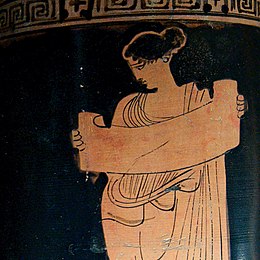
Back Непэ ADY Lees Afrikaans قراءة Arabic Llectura AST Mütaliə Azerbaijani Pagbasa BCL Четене Bulgarian পঠন Bengali/Bangla Lenn (ober) Breton Lectura Catalan
| Part of a series on |
| Reading |
|---|
 |
Reading is the process of taking in the sense or meaning of letters, symbols, etc., especially by sight or touch.[1][2][3][4]
For educators and researchers, reading is a multifaceted process involving such areas as word recognition, orthography (spelling), alphabetics, phonics, phonemic awareness, vocabulary, comprehension, fluency, and motivation.[5][6]
Other types of reading and writing, such as pictograms (e.g., a hazard symbol and an emoji), are not based on speech-based writing systems.[7] The common link is the interpretation of symbols to extract the meaning from the visual notations or tactile signals (as in the case of braille).[8]


- ^ "Definition of 'Read'". Merriam-Webster. 17 July 2023.
- ^ "READ definition and meaning | Collins English Dictionary".
- ^ Read: Reproduce mentally or vocally the written or printed words by following the symbols with the eyes or fingers; The concise Oxford Dictionary. Oxford University Press. 1990. ISBN 0-19-861243-5.
- ^ "READ | English meaning - Cambridge Dictionary".
- ^ "What is reading? Reading Rockets". 24 April 2013.
- ^ "National reading panel, Teaching child to read, Reports of the subgroups" (PDF). 2000.
- ^ Joyce, Terry, Borgwaldt, S. (2013). Typology of Writing Systems. John Benjamins Publishing. p. 2. ISBN 978-90-272-0270-3.
- ^ "What Is Braille?". The American Foundation for the Blind.
- ^ Research evidence on reading for pleasure, Department for Education, England, DFE-57519-2012. 2012.
© MMXXIII Rich X Search. We shall prevail. All rights reserved. Rich X Search